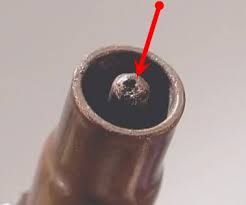A burnback in welding is when your wire burns back and sticks itself to your contact tip. There are several reasons this can happen. The most primary causes of burnbacks in a robotic application include:
- Robot Programming
- Incorrect Feeder Tension
- Wire Skipping
- Voltage Sensing Not Working
Below we’re going to detail how these causes contribute to burnbacks in your robotic welding process and then go into detail troubleshooting how to approach burnbacks to limit them in your process. Troubleshooting includes checking and evaluating the following aspect of the welding process:
- Welding Parameterization
- Properly Setting Wire Feed Tension
- Oily or Dirty Parts
Robot Programming
So to dig into some robot programming, if your contact tip to work distance becomes too close while you're welding, you can get a burnback that way, especially if you're running pulse welding.
.jpg?width=253&name=download%20(1).jpg) Another one would be if your burnback settings aren't correct from your last weld end, you could also be making contact with your part before you strike an arc. And if you're making contact with your wire to the part, you strike an arc, you can usually end up with a burnback there as well. So definitely need to be checking your contact tip to work distance use and how they're programmed, would be the first thing I'd touch on. Go ahead and elaborate if you want to, Jay.
Another one would be if your burnback settings aren't correct from your last weld end, you could also be making contact with your part before you strike an arc. And if you're making contact with your wire to the part, you strike an arc, you can usually end up with a burnback there as well. So definitely need to be checking your contact tip to work distance use and how they're programmed, would be the first thing I'd touch on. Go ahead and elaborate if you want to, Jay.
Feeder Tension is Incorrect
The biggest reason I see consistent burnback in robotic welding is because the feeder tension isn't set right. Usually this stems from your wire feeder tension not being tight enough and the weld wire barely skipping through.
What will happen then is when the robot's trying to push the wire forward, and it's barely grabbing onto that wire, your voltage is taking over, and it's burning vertically up the wire and you're getting burnback. And I've seen that many times, be that a clogged wire or pre-tension issue. That's why it's critical to understand how to set your wire pre-tension.
Wire Skipping
Wire skipping as the cause of burnback can be hard to troubleshoot because if the natural cast of your wire is more extreme or relaxed in certain places you're going to suffer burnbacks happen more often.
.jpg?width=147&name=images%20(1).jpg) There's more friction trying to push the wire through and your wheels aren't gripping it strong enough. You think you got it, and then you hit a lax part of the cast and the wire, and suddenly it works great. And it's very much a head scratcher trying to figure out where this is coming from.
There's more friction trying to push the wire through and your wheels aren't gripping it strong enough. You think you got it, and then you hit a lax part of the cast and the wire, and suddenly it works great. And it's very much a head scratcher trying to figure out where this is coming from.
So with robotic welding, that is a big issue to not overlook if you are having burnbacks and haven’t found the root cause.
Voltage Sensing Not Working
Burnback issues will also arise if your voltage sensing lead is not working. That voltage sensing lead, what that does is when the electrode or the weld wire touches the ground or the robot and sends voltage to there, it closes what's called the weld contact or weld closure relay.
When that weld closure relay closes, it tells the robot that yes, we are welding, move forward.
If that voltage feedback line is broken, or not connected, and you strike an arc, the robot will keep increasing voltage until it sees it, in which case voltage is what creates your burnback in most cases.
Troubleshooting Burnbacks
When determining the right troubleshooting process for burnbacks, what I recommend is to watch it and see if it happens at certain points in time in the welds, or in the process, or if it's happening at every weld.
Welding Parameterization
If your burnback is on the same weld every single time, go back in, look at your contact tip to work distance. Look at the tip after the burnback happens. Is it just burned back too far or is it melted into the tip? That definitely gives you an inclination of how severe the issue is.
.jpg?width=253&name=download%20(2).jpg) If your parameters seem correct, the first thing I would do on a specific weld is turn off your crater fill, turn off your burnback voltage entirely in an arc end statement in the robot That's going to eliminate any parameterization issues in the robot.
If your parameters seem correct, the first thing I would do on a specific weld is turn off your crater fill, turn off your burnback voltage entirely in an arc end statement in the robot That's going to eliminate any parameterization issues in the robot.
Now if you turn off your crater fill and your burnback settings in your arc end and you still have burnback, that's when you want to look at contact tip to work distance. Then eliminate the parameterization on the robot because right now you're just trying to track it down.
If you still have burnback issues even with that, then check your wire feed tension.
Properly Setting Wire Feed Tension
The proper way to set up weld wire feed tension, is to do it in the following steps:
- Bring your robot down to 15 to 20 millimeters above the table, the weld table, or a hard piece of metal
- Set tip to work distance when you're welding - which in most cases is 15 to 20 millimeters
- Inch out a little bit of wire, curve the wire with the pliers, and then inch the wire down so the bottom of the curve is touching the table.
- Have a colleague loosen the tension all the way.
- Hold down the inch button on the teach pendant
Nothing should happen after performing these steps because your wire feed tension is totally disengaged.
But, usually there's two tension levers. So how you get the right tension of the wire feed is by performing the following steps after disengaging the tension:
- Slowly tighten the levers until it has just enough torque to where it will curl the wire and inch it on the table, creating a slinky-like shape.
- As soon as it starts doing that, stop tightening
What that does is that ensures that during a welding process that you have enough torque on the feeder to get through any skipping or cast-related issues.
 Testing wire tension against a hard surface lets you deeply understand the torsion rates of what's going when you're welding. For instance, if you run across severe zinc or rust coating, your feeder is going to have to have enough pressure to push that weld wire into it without it melting. It can actually tattoo or cut down into that rust to get conductivity. That's one of the reasons it's very important to get your tension right because if you don't, you end up machine gunning, and it skips, causing burnback.
Testing wire tension against a hard surface lets you deeply understand the torsion rates of what's going when you're welding. For instance, if you run across severe zinc or rust coating, your feeder is going to have to have enough pressure to push that weld wire into it without it melting. It can actually tattoo or cut down into that rust to get conductivity. That's one of the reasons it's very important to get your tension right because if you don't, you end up machine gunning, and it skips, causing burnback.
This troubleshooting exercise makes sure that you're not too tight and won’t risk scaling the wire and damaging your liner when it comes in. If you do it that way, you'll never have a problem.
Oily or Dirty Parts
Oily, dirty material will also lead to burnbacks by causing the wire to skip while welding. If you have a bunch of oil on the part, it'll do a very similar thing in machine gunning much like a bad tension setting, and your process can get burnbacks that way.
If you have a really dirty nozzle, really dirty tip, and have spatter built up on the tip or the gas cup, you can create a short from a lack of maintenance, and that will also cause burnback. Be sure to either replace these parts, perform a scheduled reaming cycle, or increase the frequency of reaming cycles to control spatter buildup.
If your liners haven't been changed out at the interval that the maintenance team deems necessary depending on how much welding you do, then trying to feed through a dirty liner or a clogged liner will cause burnback every time, as well.
Any lack of wire feed either from a spattered consumable or a worn liner will make you burnback to that tip. Don’t overlook the shape of your consumables in assessing cause for burnback.

